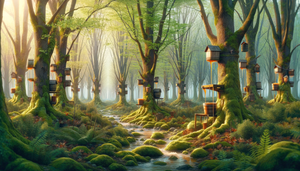Conserving Wildlife in Sugarbushes
Jul 08, 2024
Maple syrup production is a time-honored tradition that evokes images of serene forests, amber syrup, and cozy breakfasts. However, this beloved practice must balance with the need to conserve wildlife that shares the Sugarbush environment. Producers can ensure a sustainable coexistence between syrup production and wildlife conservation by implementing best practices.
Understanding the Sugarbush Ecosystem
Sugarbushes, or sugar maple forests, are more than just a source of delicious syrup. They are vibrant ecosystems home to diverse wildlife, including birds, mammals, insects, and plants. Maintaining this biodiversity is essential for the forest's health and the syrup's quality.
Key Wildlife in Sugarbushes
- Birds: Species such as the wood thrush and the pileated woodpecker rely on sugarbush habitats.
- Mammals: Squirrels, deer, and even bears are part of the sugarbush ecosystem.
- Insects: Pollinators like bees and butterflies are crucial for plant reproduction.
Best Practices for Wildlife Conservation in Sugarbushes
Balancing maple syrup production with wildlife conservation involves several best practices that ensure the sustainability of the syrup industry and the ecosystem.
Sustainable Forest Management
- Selective Tapping: Tap only a portion of mature trees to ensure tree health and long-term syrup production.
- Rotation System: Rotate tapping locations to avoid over-tapping any tree or area.
- Tree Health Monitoring: Regularly check the health of trees and address any signs of disease or stress.
Habitat Preservation
- Leave Untapped Areas: Preserve sections of the sugarbush that remain untapped to provide undisturbed habitats for wildlife.
- Create Wildlife Corridors: Ensure continuous areas of natural habitat for wildlife movement.
- Maintain Understory Vegetation: Allow native plants and shrubs to thrive, providing food and shelter for wildlife.
Biodiversity Enhancement
- Plant Native Species: Introduce native plant species that support a more comprehensive range of wildlife.
- Control Invasive Species: Manage and remove invasive plants that threaten the native ecosystem.
- Support Pollinators: Plant flowers and shrubs that attract and support pollinators.
Responsible Harvesting Techniques
- Minimize Disturbance: Use methods that reduce forest floor and habitat disruption.
- Eco-friendly Equipment: Opt for equipment and tools that have minimal environmental impact.
- Sustainable Yield: Harvest in a manner that allows the forest to regenerate and continue to provide resources.
Integrating Conservation with Maple Syrup Production
Producers can incorporate these best practices into their operations to create a harmonious balance between syrup production and wildlife conservation.
Case Study: Vermont Maple Producers
Vermont, renowned for its high-quality maple syrup, is an excellent example. Many producers in Vermont have adopted sustainable practices that enhance biodiversity and forest health.
- Community Involvement: Engaging local communities in conservation efforts and educating them about the importance of sustainable practices.
- Certification Programs: Participating in programs like the Forest Stewardship Council (FSC) certification promotes responsible forest management.
- Research Partnerships: Collaborating with universities and research institutions to study and implement best practices for conservation and production.
Benefits of Conservation for Producers
Embracing wildlife conservation in sugarbushes offers several benefits for producers:
- Enhanced Ecosystem Services: Healthier forests provide better water quality, soil stability, and resilience against pests and diseases.
- Improved Product Quality: Healthy, biodiverse forests contribute to the production of high-quality maple syrup.
- Positive Brand Image: Demonstrating a commitment to sustainability can attract environmentally conscious consumers and strengthen brand loyalty.
FAQs
Q: How does wildlife conservation impact maple syrup production?
A: Wildlife conservation enhances forest health, which supports sustainable syrup production and high-quality yields.
Q: Can I still tap my trees if I practice conservation methods?
A: Sustainable tapping practices ensure tree health and long-term productivity without compromising conservation efforts.
Q: What are some signs that my sugarbush is healthy?
A: A healthy sugarbush will have diverse plant and animal species, robust tree growth, and minimal disease or pest damage signs.
Q: How can I get involved in conservation efforts?
A: Join local conservation groups, participate in certification programs, and collaborate with researchers to implement and promote best practices.
By implementing these best practices, maple syrup producers can enjoy the sweet rewards of their labor while ensuring wildlife preservation and sugarbushes' health for generations to come.


